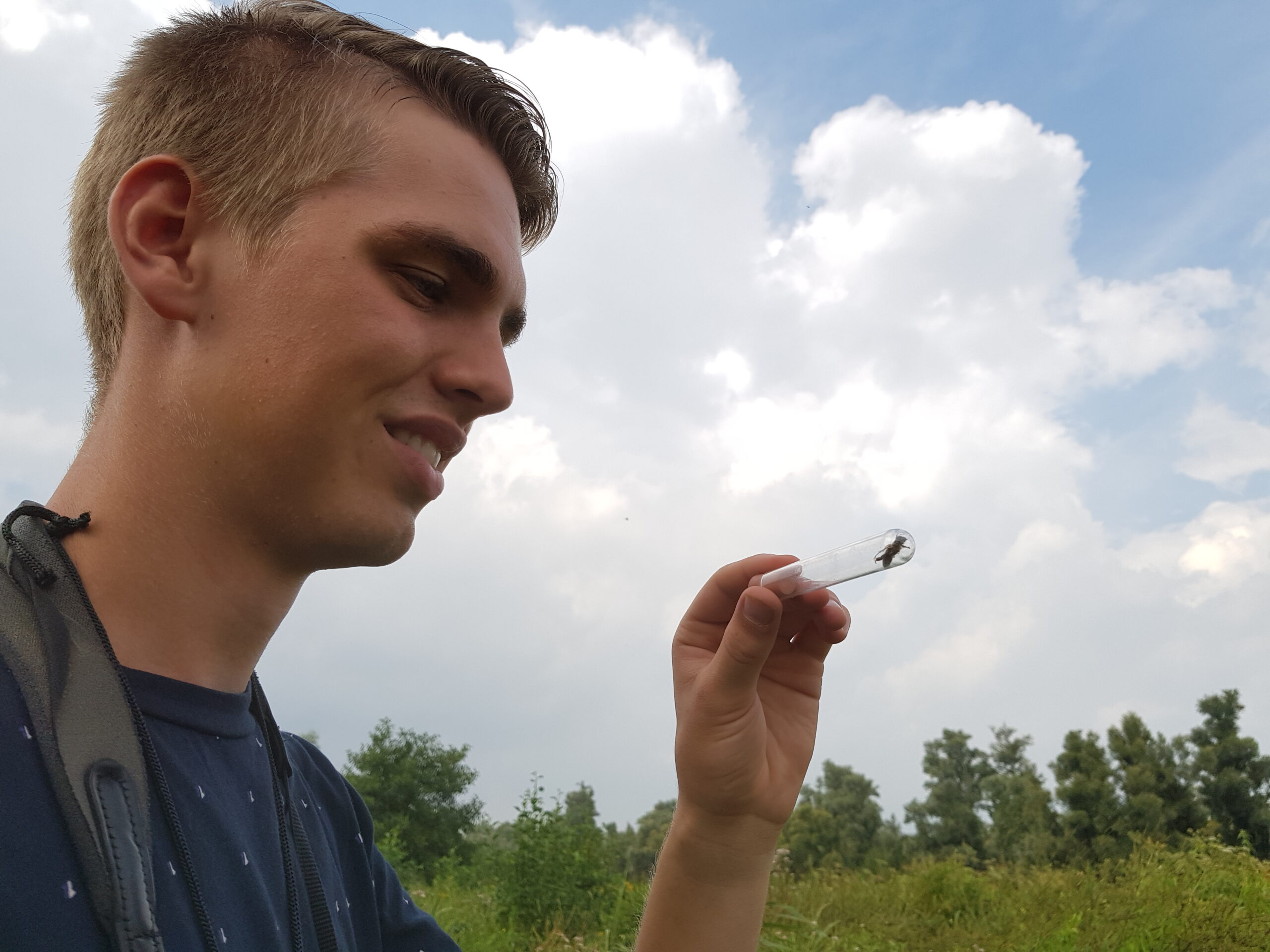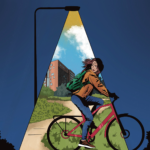We had agreed to meet in the Hoeksche Waard, Westdijk’s home territory. To be more precise: at the Esscheplaat area on the Hollands Diep River south of the village of Strijen, which is now part of a nature reserve managed by Staatsbosbeheer, the Dutch forestry service. The Ijsvogel ferry is the only entry point into the area that is overrun by policeman’s helmet (Impatiens glandulifera). Our meeting place was not a random choice, but more on that later.
‘Oh, a kingfisher. They are brooding not far from here.’ Wilson Westdijk, a second-year student of Forest and Nature Management, is at home here. In fact, all over ‘the island’, as the inhabitants of the Hoeksche Waard call it. He grew up in Maasdam, about seven kilometres to the north. He’s a nature person, and has been since primary school, he remembers. ‘And after that it got out of hand.’
That is confirmed if you study Westdijk’s track record on waarneming.nl, the website where the nature-watchers of the Netherlands keep score. On the average day, Westdijk records at least 40 observations. On 9 May he really pushed the boat out, with 253 observations. Hardly a day goes by without Westdijk feeding the website. ‘It’s a passion, yes, you could say that. My mother calls it an obsession.’
My mother calls it an obsession
Butterfly net
It’s a nice challenge for bird-watchers: to spot as many different species as possible in one calendar year. Westdijk has done something of the sort before. ‘In our group in the Hoeksche Waard, the challenge was to spot 200 species of bird. I managed that once, two years ago. The year before that I didn’t quite manage it – I got stuck at 199. That was a bit hard to swallow.’ At the end of last year, Westdijk decided to set the bar higher: 1000 species in 2020. This included a broader spectrum, because you won’t reach those numbers with birds alone in the Netherlands. So the Wageningen student began to study insects and to take along an insect net and a magnifying glass as well as binoculars. Westdijk focuses mainly on bees and flies. He doesn’t do spiders, which are not officially insects. ‘I’m not so keen on spiders,’ he admits. ‘I used to be scared of them even. But not of beetles. And they can be a lot bigger and they bite a lot harder too.’
It’s not difficult to catch insects in this area. It is hot and humid, and it rained hard last night. Westdijk fishes one insect after the other out of his net – all creatures the average walker has never heard of. ‘Look, a Palearctic hoverfly.’ This is not without its dangers, mind you. ‘I often get bitten or stung. Every day,’ he says. ‘Most bees don’t get through your skin. They are too small for that.’
A flock of storks passes overhead. ‘You don’t see them much around here. These appeared out of the sky last night.’ Westdijk puts most of the species into the system on the spot. ‘Whenever possible, I try as far as possible to find out what it is in the field. The App Opsidentify is an indispensable aid for that. ‘It identifies nearly everything. But it sometimes goes wrong with small insects. Sometimes you need to look at those through the binoculars to recognize their characteristics.’
And if he really doesn’t manage it, he puts the creepy crawlies in a glass tube and takes them home. ‘After having a good look I usually find out what they are. Or I ask other people.’ Like that one time back in June, which is the reason we are on this spot now. It was Thursday 25 June at 14.48. While out doing fieldwork for his degree course, Westdijk saw something fly by and batted it out of the air with his net. ‘At first I thought it was an ichneumon wasp, but a good friend of mine from Wageningen said it might be a longhorn beetle.’
Longhorn beetle
A book about Dutch longhorn beetles by the former WUR entomologist Theodoor Heijerman soon provided clarity. It was the Necydalis major, a species of longhorn beetle that hadn’t been spotted in the Netherlands for 40 years. ‘And before that, not for 25 years. That earlier sighting was in Dremmelen, not far from here as the crow flies.’ Someone Westdijk knows, a journalist with the local paper Het Kompas, wrote about the find, and the news reached Wageningen.
I often get bitten or stung. Every day
‘Hey, a fish eagle!’ His enthusiastic tone suggests this is not a daily visitor. ‘I sometimes see them at the Blauwe Kamer in Wageningen. This one is on its way somewhere. In the Biesbosch nearby, there are three mating pairs. The only ones in the Netherlands.’ Nature never gets boring. There is always something new to see, says Westdijk. ‘I know this area pretty well, but nature is always changing. Especially with those insects, it goes on and on. The different species’ flying seasons come one after the other in quick succession.’
‘If you don’t come here for a week, the situation has changed completely,’ he adds. ‘But you do have to come across them, of course. Like that longhorn beetle. It has to just be flying by when you are there.’ He’s reached 1000 species, but the ‘competition’ just goes on. ‘I won’t reach 1500. It’s going more slowly now. But 1200-1300 should be possible. There will be a few more.’

 Wilson Westdijk. Photo: Roelof Kleis
Wilson Westdijk. Photo: Roelof Kleis 

